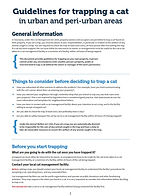Cats in the neighbourhood
Did you know that the average outdoor domestic cat roams an area of 1.4 hectares around their home? That means they can visit 14 neighbouring properties a week and could potentially become a nuisance to some of your neighbours. Keep your community happy by keeping your cat safe at home.
How far do domestic cats roam?
Many cat owners are unaware how far their cat wanders from home. A project that tracked 11 domestic cats in the north-west of Tasmania showed that those cats had a median home range of 1.4 hectares, ranging from 0.2 to 7 hectares. To put things into perspective one hectare equals 100x100 metres and is approximately ten quarter-acre residential blocks. This means that cats might visit 14 neighbouring properties a week. These cats also crossed an average of three roads per day, with some of them crossing up to 13 roads a day.
Download the full Cradle Coast Cat Tracker Report.


How do cats cause a nuisance?
-
By scent marking and defecating around neighbours' properties
-
By fighting with other neighbourhood cats or agitating neighbours' dogs
-
By yowling during the night
-
By creating traffic hazards while darting across roads
-
By hunting wildlife on neighbours’ properties
Are you concerned that your cat may be causing a nuisance in your neighbourhood?
Have a look at our tips and advice on keeping your cat happy at home or how to build a cat enclosure.
Here are a few things you can do about a nuisance cat on your property
-
Can you identify the cat's owner? Try addressing the issue directly with the owner. Often all it takes is a friendly conversation with your neighbour to resolve the problem.
-
Not sure who owns the cat? You can try dropping off some friendly letters in your neighbours' letterboxes. We've got a handy letter template for you to use. Download it here.
-
Do you want to provide your neighbours with some information about responsible cat ownership? Download this printable infographic.
-
You can cat-proof your yard. Download our brochure on nuisance cats for some handy tips and tricks.
5. When you have exhausted all other avenues you have the option of trapping the cat. Before you decide to
start trapping, there are a number of things you need to consider:
-
Under the Animal Welfare Act 1993, if you set a trap you are automatically deemed to be responsible for the care of any animal caught in the trap and have a duty to take all reasonable measures to ensure the welfare of any animal caught in the trap.
-
All trapped cats will have to be returned to their owner or taken to a cat management facility or their nominee, within 24 hours of the cat being trapped.
-
Have you been in contact with a cat management facility about your intention to set a trap, and is the facility willing to accept a trapped cat?
-
Have you advised your neighbours through a letterbox drop that you intend to trap any cats that roam onto your property? This is not required by legislation but is considered good practice. A template for a neighbourhood letter on cat trapping can be downloaded here.
-
Will you be able to check the trap at least once, but preferably twice a day?
-
Are you able to safely transport the cat by car to a cat management facility within 24 hours of it being trapped?
Before setting a trap, a person needs to contact their local cat management facility to understand the facility’s processes for accepting a cat and any associated fees.
Cat management facilities are run by not-for-profit organisations and operate on public donations and other fundraising activities and they may request a fee when you hand in a cat. It is very important to consider this information before deciding to trap a cat.


_cropped.jpg)